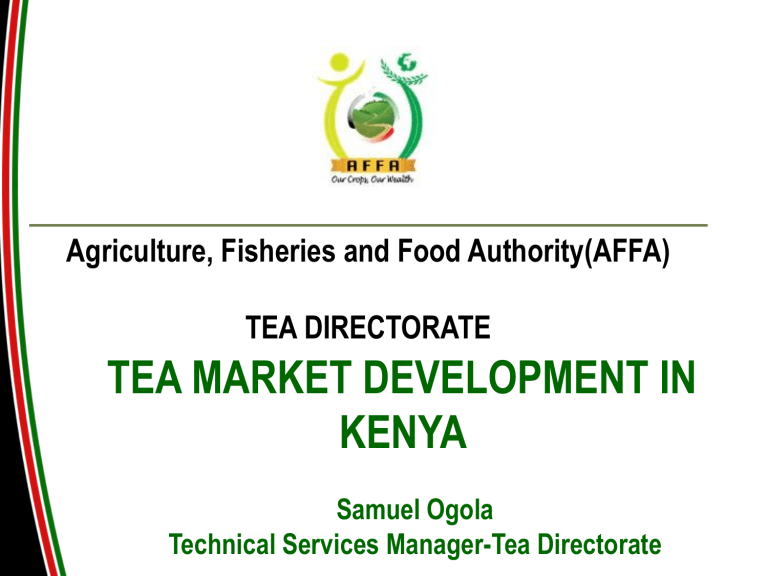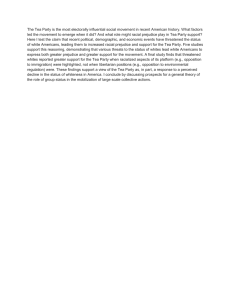TEA MARKET DEVELOPMENT IN KENYA Agriculture, Fisheries and Food Authority(AFFA) TEA DIRECTORATE

Agriculture, Fisheries and Food Authority(AFFA)
TEA DIRECTORATE
TEA MARKET DEVELOPMENT IN
KENYA
Samuel Ogola
Technical Services Manager-Tea Directorate
Contribution to Economy
Tea Contributes immensely to socio-economic development of the country:
• It is the leading foreign exchange earner-23% of the total foreign exchange earnings.
• 4% of the GDP.
• livelihood support to over 5 million Kenyans.
• Contributes to Rural development.
• In 2013, the tea industry earned the country Kshs. 114 Billion (Usd
1.33 Billion) in export earnings and Kshs. 22 Billion (Usd 0.26) in local sales.
Role In the Industry
Regulation and compliance
Industry planning and development
Industry advocacy
Trade and promotion
Organizational capacity and service delivery enhancement
Key Industry Statistics
No.of Growers
Hectarage
No.of factories
Total
Smallholder
Plantation
Total
Smallholder
Plantation
Total
Smallholder
Plantation
2011
639,521
606,744
32,777
187,855
123,385
64,470
104
64
40
2012
627,938
595,152
32,786
190,717
124,985
65,732
105
64
41
2013
614,159
575,103
39,056
198,657
127,352
71,305
107
64
43
Stabilized Production levels
(Million Kgs)
500
450
400
350
300
250
200
150
100
50
0
314
399
377 y = 20,6x + 316,4
369
2009 2010 2011
Year
2012
432
2013
Export Trends (Million Kgs)
600,00
500,00
400,00
300,00
200,00
100,00
0,00
342,48
441,02
421,27
430,20
2009 2010 2011
Year
2012
494,35
2013
Increasing Export Values (billion
K.sh)
120
114
109
112
100 97
80
69
60
40
20
0
2009 2010 2011
Year
2012 2013
Efforts to Grow Exports(2009-2013)
25%
20%
15%
10%
10%
5%
0%
PAKISTAN
-5%
1%
EGYPT
22%
7%
8%
6%
-1%
UK AFGHANISTAN SUDAN EMERGING TOTAL
Improving Local Consumption (Million
Kgs)
30
26
25
22,7
20
20
19
18
15
10
5
0
2009 2010 2011 2012 2013
Global Supply/Demand Trend (Million Kgs)
5 250
5 000
4 750
4 500
4 250
4 000
3 750
3 500
3 250
3 000
2 750
2 500
2 250
2 000
1 750
1 500
1 250
1 000
750
500
250
-
2004 2005 2006 2007
Supply
2008 2009
Demand
2010 2011 2012 2013
Declining Tea Auction Prices (2013-2014-To Date)
3,50
3,00
2,50
2,00
1,50
1,00
0,50
0,00
Auction No.
Our Challenges
Sustained increase in production (Black CTC tea) leading to global oversupply.
Global supply is growing at higher rate than demand by about 3% annually.
Slow adaptation to product and Market diversification e.g “Orthodox ,Specialty teas etc. .
Origin Branding
Low consumption patterns in Africa.
Continued
Declining Tea prices leading to Reduced grower earnings (30%)
Rising Cost of Production (COP);
Many private standards and diverse regulatory requirements by respective importing countries.
Low innovation along the value chain
Opportunities to Promote Tea
Promotion of value addition for Kenya teas, a target of 20% has been projected:
Increased populations in Africa and Asia
Increased awareness of health benefits of tea in
Europe and America .
Increased income levels and expanding middle class globally .
Low consumption in Africa ,currently Africa has a population of 1.1 Billion with a low consumption of 0.30kg per capita
15. Continued …….
Promotion of tea based on Origin.
Adopting product diversification and innovation e.g Purple tea, Orthodox tea, White tea e.t.c.
Adoption of cottage Industry models to promote specialty and niche teas segments.
Conclusion ……….
Prepared a National Tea Policy towards improving competitiveness and sustainability of the Industry.
Developed Kenya Climate Change Strategy for the
Tea Industry in collaboration with FAO .
Automation of the tea Auction with a view to improving transparency and enlarge competition;
Commissioned a study on Price Stabilization Fund
(PSF)and Min. Greenleaf rate to the growers .
Thank You!
Agriculture, Fisheries and Food
Authority(AFFA)
TEA DIRECTORATE



